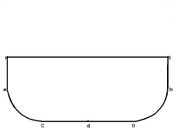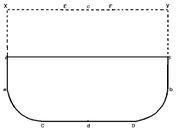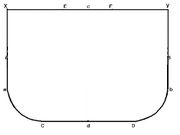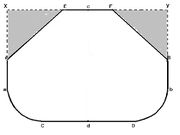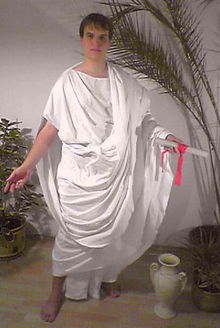Toga
(+photo) |
(move Lentulus' material here. adjust format) |
||
| Line 4: | Line 4: | ||
[[Image:Priest togate capite velato.jpg|right|thumb]]The '''toga''' is the definitive garment of the [[Roman]] male. It is worn over a [[Tunica|tunic]]. | [[Image:Priest togate capite velato.jpg|right|thumb]]The '''toga''' is the definitive garment of the [[Roman]] male. It is worn over a [[Tunica|tunic]]. | ||
| + | |||
| + | ==Social meaning of the toga== | ||
==Types of Toga== | ==Types of Toga== | ||
| Line 11: | Line 13: | ||
;Toga pura (or toga virilis): The ordinary [[Citizen|citizen's]] toga. It is undyed, and thus off-white or cream coloured. | ;Toga pura (or toga virilis): The ordinary [[Citizen|citizen's]] toga. It is undyed, and thus off-white or cream coloured. | ||
| − | |||
;Toga praetexta: The toga worn by [[Magistrate|magistrates]] (and also by boys under the age of 16). It bears the purple stripe, the width of which varies according to the wearer. [[Senator|Senators]] and magistrates holding [[Imperium|imperium]] wear a broad (3") purple stripe. Members of the [[Ordo Equester]] and magistrates without imperium wear a thin (1") purple stripe. Such stripes do not go all the way around the toga, but instead are placed on edge BEFA on the diagram (the upper-half of the toga). | ;Toga praetexta: The toga worn by [[Magistrate|magistrates]] (and also by boys under the age of 16). It bears the purple stripe, the width of which varies according to the wearer. [[Senator|Senators]] and magistrates holding [[Imperium|imperium]] wear a broad (3") purple stripe. Members of the [[Ordo Equester]] and magistrates without imperium wear a thin (1") purple stripe. Such stripes do not go all the way around the toga, but instead are placed on edge BEFA on the diagram (the upper-half of the toga). | ||
| Line 21: | Line 22: | ||
;Toga trabea: A multi-coloured toga, bearing purple and scarlet stripes, worn by [[Augur|Augurs]]. | ;Toga trabea: A multi-coloured toga, bearing purple and scarlet stripes, worn by [[Augur|Augurs]]. | ||
| + | |||
| + | ==Evolution of the toga== | ||
| + | [[Image:Original_cemicircular_form.jpg|thumb|right|Semicircular form.]] | ||
| + | === The primitive toga === | ||
| + | |||
| + | This was original semicircular form in the republican times until the 1st century BC, which can be seen [http://www.vroma.org/images/mcmanus_images/toga3.jpg on this statue]: | ||
| + | |||
| + | === Development during the 2nd-1st centuries BC === | ||
| + | |||
| + | [[Image:Enlargement_phase1.jpg|thumb|right|End of 2nd c. BCE]]In the end of the 2nd century BCE, the aristocracy started to enlarge their toga to have a more impressive draping. They increased the width of the material bigger and bigger through the decades. | ||
| + | |||
| + | [[Image:Enlargement_phase2.JPG|thumb|right|Enlarged form.]]Now they had a very large toga draped the way seen [https://oncourse.iu.edu/access/content/user/leach/www/2003/summer02/togatus2.jpg on this statue], and a bit later, this version of draping became even more popular at the end of the republic with the ''sinus'', seen [http://www.vroma.org/images/raia_images/togaedman.jpg on this statue]: | ||
| + | |||
| + | === The classical toga - theories about its shape === | ||
| + | |||
| + | But having this new fashion of draping and the large measure of the material, they had problem with it's falling from the back and in the first part under the visible draping downstage, caused by the lots of material in the corners "x" and "y". Also, they continued to increase the width to have a larger sinus, and it caused even more problems because of those "too much material" corners, so they simply started to cut down the corners. | ||
| + | |||
| + | ===="Theory 1"==== | ||
| + | |||
| + | [[Image:Toga_shape_hypothesis2.jpg|thumb|right|"Theory 1"]] | ||
| + | |||
| + | |||
| + | An other hypothesis says that they cut it down in a semicircular way, so they had an oval, ellipsis-like shape: | ||
| + | |||
| + | ===="Theory 2"==== | ||
| + | |||
| + | [[Image:Toga_shape_hypothesis1.jpg|thumb|right|"Theory 2"]] | ||
| + | |||
| + | |||
| + | ===Final shape === | ||
| + | |||
| + | [[Image:Lentulus togatus.jpg.jpeg|right||220px]] | ||
| + | I think that the even cutting is more likely because it is a more simple solution; anyway, they now had [http://www.romancoins.info/p-augustus-statue-vat.JPG this variant of the toga] that is called "imperial", and was worn during the principate. I think "classical toga" is a better name for this variant, because it is which became the most symbolical and characteristical version of the Roman toga. | ||
| + | |||
| + | In the photo at right, you can see my classical toga which is made according to the "Theory 1": | ||
| + | |||
| + | Please compare it yourselves with ones on the Roman statues, like [http://www.geocities.com/Athens/Parthenon/7094/titus3.jpg this], or [http://www.vroma.org/images/mcmanus_images/nerochild.jpg this], or [http://www.virginia.edu/artmuseum/WE_List_Large/images/Togata-5.jpg this] and so on... | ||
==References== | ==References== | ||
Revision as of 13:05, 18 August 2008
Home | Latíné | Deutsch | Español | Français | Italiano | Magyar | Português | Română | Русский | English
⚜⚜⚜ Site Index - Key Pages ⚜⚜⚜
For making and wearing a toga, see Toga (Nova Roma).
The toga is the definitive garment of the Roman male. It is worn over a tunic.Contents |
Social meaning of the toga
Types of Toga
As far as the colouring of the wool itself, there were several types of toga:
- Toga pura (or toga virilis)
- The ordinary citizen's toga. It is undyed, and thus off-white or cream coloured.
- Toga praetexta
- The toga worn by magistrates (and also by boys under the age of 16). It bears the purple stripe, the width of which varies according to the wearer. Senators and magistrates holding imperium wear a broad (3") purple stripe. Members of the Ordo Equester and magistrates without imperium wear a thin (1") purple stripe. Such stripes do not go all the way around the toga, but instead are placed on edge BEFA on the diagram (the upper-half of the toga).
- Toga candida
- The stark-white toga worn by candidates running for office. The English word "candidate" comes from this usage.
- Toga pulla
- A dark toga, either brown, dark gray, or even black, worn while in mourning.
- Toga picta
- A special toga worn only by military commanders being given a triumph. It is pure purple with decorations in golden thread.
- Toga trabea
- A multi-coloured toga, bearing purple and scarlet stripes, worn by Augurs.
Evolution of the toga
The primitive toga
This was original semicircular form in the republican times until the 1st century BC, which can be seen on this statue:
Development during the 2nd-1st centuries BC
In the end of the 2nd century BCE, the aristocracy started to enlarge their toga to have a more impressive draping. They increased the width of the material bigger and bigger through the decades. Now they had a very large toga draped the way seen on this statue, and a bit later, this version of draping became even more popular at the end of the republic with the sinus, seen on this statue:The classical toga - theories about its shape
But having this new fashion of draping and the large measure of the material, they had problem with it's falling from the back and in the first part under the visible draping downstage, caused by the lots of material in the corners "x" and "y". Also, they continued to increase the width to have a larger sinus, and it caused even more problems because of those "too much material" corners, so they simply started to cut down the corners.
"Theory 1"
An other hypothesis says that they cut it down in a semicircular way, so they had an oval, ellipsis-like shape:
"Theory 2"
Final shape
I think that the even cutting is more likely because it is a more simple solution; anyway, they now had this variant of the toga that is called "imperial", and was worn during the principate. I think "classical toga" is a better name for this variant, because it is which became the most symbolical and characteristical version of the Roman toga.
In the photo at right, you can see my classical toga which is made according to the "Theory 1":
Please compare it yourselves with ones on the Roman statues, like this, or this, or this and so on...
References
Master Index
Master Index > English > Nova Roma
Master Index > English > Nova Roma
Master Index > Maintenance Categories > Pages to be deleted
Master Index > Maintenance Categories > Pages to be deleted > Photo Galleries
Master Index > Maintenance Categories > Pages to be deleted > Via Romana > Roman Clothing and Equipment
Master Index > Maintenance Categories > Pages to be deleted > Via Romana > Roman Clothing and Equipment > Toga
